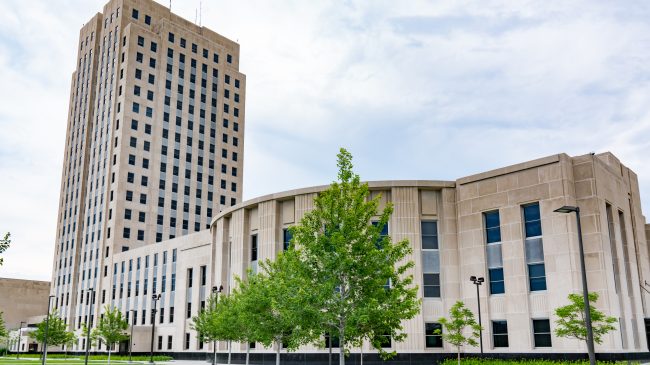Testimony Before the North Dakota House of Representatives Government and Veterans Affairs Committee on House Bill 1209
Chairman Koppelman, committee members, thank you for inviting me to offer a brief technical assessment on House Bill 1209 and the implications of the state adopting an actuarially determined employer contribution funding policy—commonly referred to as the ADEC rate—to address the state’s worsening public pension underfunding and put the North Dakota Public Employees Retirement System (NDPERS) on a sustainable fiscal trajectory.
My name is Raheem Williams and I serve as a policy analyst with the Pension Integrity Project at Reason Foundation, a national 501(c)(3) libertarian-leaning think tank that offers pro-bono technical assistance and policy research to public officials and other stakeholders to help design and implement policy solutions aimed at improving public pension plan resiliency, promoting retirement security for public employees, and lowering long-term financial risks to taxpayers. I am also a former NDSU research specialist and am currently collaborating with them on an independent assessment of NDPERS’s long-term solvency.
Public pension systems like NDPERS rely on contributions from public employees and their public employers—as well as compounding investment returns—over long periods of time to save the necessary amount of funding needed to pay the retirement benefits promised to generations of public employees.
Over the last 20 years, NDPERS has gone from 115 percent funded and a surplus of $135 million to holding over $1.4 billion in earned, yet unfunded, pension obligations that are implicitly protected by both the state and federal constitutions.
Over $585 million of that $1.4 billion in NDPERS pension debt—nearly a third—can be attributed to the way the state systematically underfunds its largest public pension system, according to annual public reports published by NDPERS. In their most recent report, NDPERS actuaries determined that the state needed to contribute 12.94 percent of payroll to put the plan on the path to full funding. However, the statutory contribution rate established in state law is only 7.16 percent of payroll, shorting NDPERS the 5.78 percent needed to get back on track to full funding.
The consistent practice of setting NDPERS contribution rates too low in state law instead of paying the amount actuaries calculate is needed each year to stay on track to meet promises has consistently shorted the system of expected revenue, every single year for the last 18 years (2003-2020). In short, the state is structurally underfunding the plan, which only drives up costs for taxpayers since, like any debt, pension debt that is not paid down will only grow. If not addressed, the system will never reach full funding, nor will the current funding method ever pay down the current $1.4 billion in pension debt. This only drives up the cost to taxpayers of providing constitutionally protected pension benefits higher and higher.
The reason the current NDPERS funding policy is broken is simple. By statutorily setting contribution rates below the ADEC rate policymakers ensure expected revenue will never make it into the fund to be invested, and thus will never earn a return. To put this in context, the fund was shorted $1.6 million in 2003—that’s $1.6 million that did not earn a return in subsequent years. This effectively compounds each year as not only the plan’s growth is stifled but interest on the debt is accumulated. According to NDPERS’ 2020 Comprehensive Annual Financial Report, the annual contribution deficiency has grown to $55 million.
Ignoring pension obligations is a costly decision that puts taxpayers at risk, threatens retirement security for retirees, and runs counter to prudent stewardship of public finances. Courts nationwide have interpreted pension benefits as contractual obligations that have to be paid, one way or the other. Generally speaking, in the context of underfunded pensions, debt is debt—you either pay more now or pay even more later.
And credit rating agencies routinely evaluate pension solvency as they make credit rating determinations, generally taking a dim view of pension underfunding and demonstrating a willingness to issue improved forecasts or even credit rating upgrades in states like Michigan and Colorado that have recently enacted similar pension funding policy reforms designed to pay down pension debt faster.
Furthermore, the Society of Actuaries Blue Ribbon Panel on Public Pensions Funding advises that a plan should not settle for any level of funding below 100 percent and should always guide their funds to reach full funding within 20 years or less and under a median level of possible long-term returns.
The increases needed now to meet the ADEC rate will pale in comparison to maintaining the structural underfunding of today and the ever-compounding accumulation of pension debt. ADEC funding alone will not guarantee the plan reaches full funding, nor will it address the systemic risk inherent in making assumptions about future investment returns and demographic changes. However, shifting to the use of an actuarially determined contribution rate for NDPERS would be a prudent funding policy step to ensure that today’s missed contributions do not become the financial burden of tomorrow’s North Dakotans.
Stay in Touch with Our Pension Experts
Reason Foundation’s Pension Integrity Project has helped policymakers in states like Arizona, Colorado, Michigan, and Montana implement substantive pension reforms. Our monthly newsletter highlights the latest actuarial analysis and policy insights from our team.

